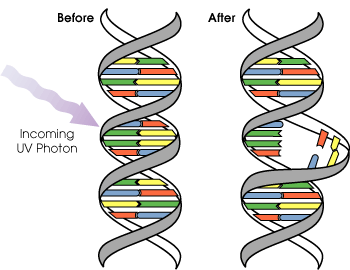Science Seen Physicist and Time One author Colin Gillespie helps you understand your world.
Managing the Damage on the Beach
Last week we looked at how adopting smart sun habits―tan, but never burn―minimizes your risk of many cancers and of other serious diseases. Now let’s take a closer look at physics that is triggered when you catch some rays, because there’s something else that you may want to do.
A solar UVB photon has enough energy to damage one strand―but not both strands―of the double-helix DNA in a skin cell. Within minutes of such damage a repair enzyme (a protein molecule) comes to your rescue. It snips out the damage and rebuilds the strand. It gets your genetic message right because the other strand records exactly the same information (like a photo and its negative). Almost as fast as photons do their damage the repair system is fixing it unless, by sheer bad luck, another photon damages the other DNA strand in the vicinity before the first repair is done. The resulting double-strand damage could cause the stricken cell to go a little crazy; too much of this can cause cancer.
 Back in the 1970s David Dugle and I showed how the single-strand repair system in mammalian cells depends on temperature. Not surprisingly, near freezing point it’s slow. Also not surprisingly, it’s faster at normal body temperature, 37 °C. What’s of interest for present purposes is that, only a few degrees warmer than 37 °C, the repair rate crashes. (My bet is: The enzyme molecule loses the special shape that, like a key turning a lock, enables it to do its work―shades of how to cure your cold.)
Back in the 1970s David Dugle and I showed how the single-strand repair system in mammalian cells depends on temperature. Not surprisingly, near freezing point it’s slow. Also not surprisingly, it’s faster at normal body temperature, 37 °C. What’s of interest for present purposes is that, only a few degrees warmer than 37 °C, the repair rate crashes. (My bet is: The enzyme molecule loses the special shape that, like a key turning a lock, enables it to do its work―shades of how to cure your cold.)
Think of sitting, lying, talking, playing on a sunny shore. Although your skin cells have this terrific DNA repair system, if your skin’s hot your repair crew is on strike. Single-strand damage is accumulating and the odds of double-strand damage are soon going through the roof (increasing with the square of your exposure.) So when you’re on that sunny shore remember this hot tip: Every ten or fifteen minutes take a cooling dip and give your skin a chance to fix its DNA.
At the personal level smart sun habits can give your health and life expectancy a boost. In the wider picture, replacing simplistic scare-mongering with a smart sun message could decrease healthcare costs.
We can understand, have fun, live longer and have better health . . . and pay less!
Sources
David Dugle & Colin Gillespie (1975), “Kinetics of the Single-Strand Repair Mechanism in Mammalian Cells” in Molecular Mechanisms for Repair of DNA, (eds. Philip Hanawalt & Richard Setlow), New York: Plenum Press, vol. B, p. 685; http://www.ncbi.nlm.nih.gov/pubmed/1191190
Don Chapman & Colin Gillespie (1981), “Radiation-Induced Events and Their Time Scale in Mammalian Cells” in Advances in Radiation Biology, (ed. John Lett), New York: Academic Press, vol. 9, p. 143; http://www.jstor.org/discover/10.2307/65515
Image: Ultraviolet (UV) photons harm the DNA molecules of living organisms in different ways. In one common damage event, adjacent bases bond with each other, instead of across the “ladder.” This makes a bulge, and the distorted DNA molecule does not function properly. (Illustration by David Herring) via NASA http://earthobservatory.nasa.gov/Features/UVB/
Other Reading
David Dugle, Colin Gillespie & Don Chapman (1976), “DNA strand breaks, repair and survival in X-irradiated mammalian cells”,Proc. Nat. Acad. Sci. USA, vol. 73, p. 809; http://www.pnas.org/content/73/3/809.full.pdf
Don Chapman & Colin Gillespie (2013), “The Power of Radiation Biophysics―Let’s Use It”, International Journal of Radiation Oncology, Biology & Physics, New York: Elsevier, vol. 84, p. 309; http://www.redjournal.org/article/S0360-3016%2812%2900567-6/fulltext

No comments yet.